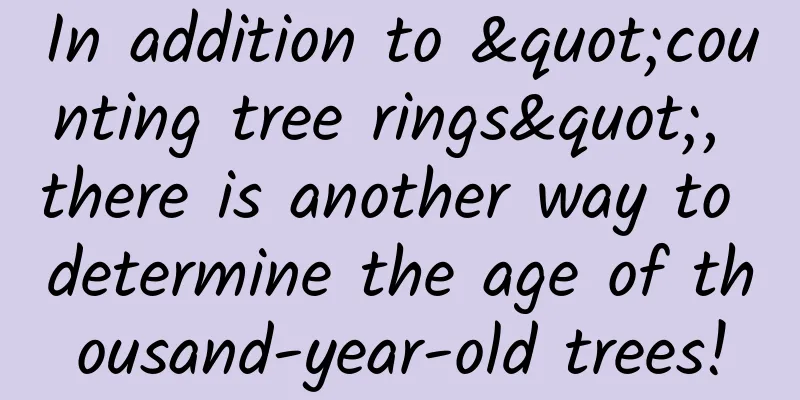In addition to "counting tree rings", there is another way to determine the age of thousand-year-old trees!

|
There is such a joke: Under a tree, a young man asked an experienced tree planter: "How can you tell the age of this tree?" The old man patted his chest and said: "This is easy, let me do it." Then he rolled up his sleeves, chopped the tree down with a few axe, and slowly counted the tree rings... Of course, although the principle is correct, this is just a joke. This "killing the chicken to get the eggs" method of counting tree rings will definitely not be used in daily life, because even if the tree rings are counted, the tree will be dead. So here comes the question: We often see some protected ancient trees with a sign saying that the tree is hundreds or thousands of years old. So how is the age of these trees measured? How do scientists know the age of a tree without cutting it down? 01 How big is the old tree? Let me drill it. I have participated in such work. Although it does not require cutting down trees, it is still strenuous work. That was in 2018. I was invited by a friend to go to Mount Siguniang to participate in an ecological scientific expedition. The square-branched cypresses here are towering into the clouds, and trees that are several people thick enough to hug are everywhere. Photo provided by the author | Note that there is another person in the woods The sea buckthorn here is a major attraction, and it is said that it was brought from Inner Mongolia during the reign of Emperor Kangxi. Every year, the blue robins that gather on the tall sea buckthorn trees to "eat" become a beautiful scenery ; the original red spruce forest at an altitude of 3,000 to 4,000 meters is the highest altitude original coniferous forest in China. Standing under them, I often sigh at my insignificance. Because the old trees here are densely populated, one of the important tasks of our scientific expedition is to measure their age. Photo provided by the author | There are many blue robins on the tall sea buckthorn trees To know the exact age of a tree, counting its growth rings is still a hurdle that must be overcome. However, for these precious old trees, we cannot use simple and crude methods such as an axe. We can use a small tool to minimize the damage to the tree - just use a special drill bit to take out a small section of the wood. This drill is called a "growth cone" . Its structure is very simple. It is a "T" shaped drill. The drill bit is hollow. The cylindrical section drilled in the tree is called the "tree core". There is also a handle perpendicular to the drill pipe. Yes, this kind of delicate work has to be done by ourselves (if you are not careful, you will break the tree). Image courtesy of the author | The blue handle and the drill bit in front are the growth cones The principle sounds simple and the name sounds a bit high-sounding, but the operation is absolutely a pure physical job. First find a big tree to drill the core of, and find the center at the height of the trunk corresponding to our chest. We must be able to drill accurately into the center of the annual ring. This is very important, just like we don't want the nurse to repeatedly prick us with an injection but fail to hit the vein. If the operator is careless, he drills in once, takes out the core of the tree, and finds that it doesn't hit, and tries again, and again... If the tree could talk, I'm afraid it would also "swear". How strenuous is this physical work? How much effort is needed depends on the "physique" of the tree. Different trees have different textures, and the difficulty of drilling trees is also different. Take my scientific expedition to Mount Siguniang for example. Perhaps it was the severe cold at high altitudes that made the trees grow particularly strong. It seemed that the trees we drilled were not willing to let us measure their age. Several people surrounded the tree. One person went up first, poking hard with a red face. It took a lot of effort to get the drill bit stuck in the tree. Then another person continued to go up. After several waves, it suddenly became easy when it was close to drilling into the center of the tree. Huh? Something is wrong. I took it out and saw that the center of the tree was rotten and useless. There was no information about the center annual ring. It was a waste of drilling. After this wave of operations, a group of people were exhausted and had to relax for a while before continuing to the next tree. **Because the wood of old trees is hollow dead cells, rotting is common. **There are also tree species that are definitely not hollow, such as various redwoods. Anyway, I can't imagine what it's like to measure the age of redwood. I don't know if the drill bit can get in, and I don't know how many drill bits will be wasted. Fortunately, although the tree we surveyed was difficult, it was still possible. **Generally speaking, it is enough to drill a little more than half of the tree core, and there is no need to "drill through it in one shot". **For other ecological research needs (in addition to showing age, annual rings can also show information such as temperature changes and light conditions in different years), three holes will be drilled on a tree at an angle of 120 degrees. The drilled cylindrical tree core will be temporarily stuffed into a straw. Yes, you heard it right, the straw we use to drink milk tea can also be used in this way. The straw is very convenient to carry, and the hard plastic shell can well protect the tree core from being damaged and broken. Photo provided by the author | Tree core to be polished Then I returned to the experiment and took it out and placed it in a square slot. At this time, the surface of the tree core was rough and the annual rings were not clearly visible. It needed to be polished with sandpaper, and the traces of the annual rings would appear. No more nonsense, after a series of operations, I could finally count the annual rings. Photo provided by the author | Polished tree core 02 Not all trees can be drilled. As we mentioned earlier, **drilling the core of a tree can minimize the damage, but it still hurts the tree. **For young trees, this is not a big problem, but most of the trees whose ages are measured are those that are "old and frail" and have been around for who knows which dynasty. Not to mention that they are often scarred and it is difficult to drill a few complete annual rings, not to mention that the tree is old and always weak, and a small hole may be the last straw that breaks the camel's back, so drilling must be done with extreme caution. So, how are the ages of these protected ancient trees measured? For ancient trees in famous cultural attractions, historical methods may be more accurate (remember "There is a loquat tree in the yard, which was planted by my wife in the year of her death. Now it has grown tall and majestic."?). However, in ecology, we mostly measure trees in deep mountains and old forests that no one cares about. In this case, we still have to drill holes, but we cannot drill old trees. Instead, we have to drill young trees nearby (young trees: "Are you polite?"). This is because there is a certain relationship between the age of a tree and its diameter at breast height. As it grows one year older, it will become thicker. **So by measuring the ratio of the age to the breast height of small trees of different ages around it and making a curve, we can calculate the approximate age of the old tree through its breast height. **However, this method is not accurate enough. After all, the climate may change over the past few hundred years, so the growth of the tree will also be different every year. Anyway, although we have relatively mature tree age measurement skills, we still have to try it ourselves to understand how difficult it is. Every time we stand in front of a tree, holding a growth cone, we really hope that the old trees can introduce themselves to each other like we do to each other: Hey, little kids, I'm an old man and I'm 1024 years old this year. Author | Ye Zhengrong Review | Wang Kang Director of Beijing Botanical Garden Science Center Professor-level Senior Engineer This article is produced by the "Science Rumor Refutation Platform" (ID: Science_Facts). Please indicate the source when reprinting. The pictures in this article are from the copyright gallery and are not authorized for reproduction. |
<<: Osmanthus is so fragrant, why is it wrong to make it into osmanthus-scented perfume?
>>: Did aliens really draw a circle in the desert?
Recommend
15 key activity designs in the social network operations of 5 major brands
When it comes to community operations , many peop...
As early as 60,000 years ago, did Australian people achieve "nut freedom"?
Macadamia nuts are the only native Australian pla...
Why are foldable phones popular but not commercially successful?
Two years ago, foldable phones were popular for a...
In information flow delivery, how can one plan carry the entire account effect?
I would like to talk about the topic of testing p...
Vue develops WeChat H5 and solves the problem of WeChat sharing signature failure
Regarding the use of history mode in Vue routing,...
iPhone 6S A9 processor details revealed! Apple is going crazy
There are currently two unsolved mysteries about ...
What to do if iPhone message reception is delayed? In fact, changing the time zone will eliminate the delay, which is very practical
Have you ever encountered this situation when usi...
5 signs that you may have sarcopenia! Be sure to do these two things!
Whether you are at work or at home recently In fa...
Zxing scan code example
Source code introduction An example of Zxing scan...
China Automobile Dealers Association: Weekly analysis of the auto market from May 1 to May 8, 2022
1. Overview of the auto market this week From May...
Power generation depends on waves! Have you ever seen wave power generation?
Wave energy is a type of ocean energy that appear...
How much do you know about Hawking's legendary story? Are his predictions and warnings reliable? (I)
Hawking's full name is Stephen William Hawkin...
Why is Typhoon Prasang moving so fast? Will it be the heat terminator?
Zhejiang Weather released the latest news at 11:0...
360 Mobile Phone N4 Enjoyable Experience: Can It Be the Best Phone Under 1,000 Yuan?
In 2016, Qihoo and Dasheng were gradually no long...
How to do product competitive analysis?
When we talk about competitive analysis , what ar...









